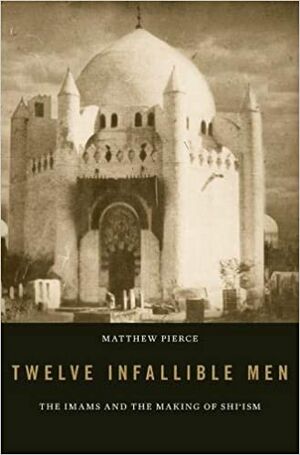Twelve Infallible Men: The Imams and the Making of Shi’ism
The book Twelve Infallible Men: The Imams and the Making of Shi’ism makes use of the discourse on social memory in an effort to more fully understand the classical Shi’a biographies of the imams.
 | |
| Author | Matthew Pierce |
|---|---|
| Language | English |
| Published | 2016 |
| Publisher | Harvard University Press |
| Pages | 272 |
About the author[edit | edit source]
Matthew Pierce (born December 3, 1977) is an entrepreneur, university lecturer, and game designer. He is a former NCAA Champion and was a member of the United States Men's National Swim Team. He attended Stanford University, where he was a member of the men’s swimming and diving team. The team won the NCAA Championship in 1998. Pierce was an All-American, an NCAA Champion in the 200-yard butterfly and a Gold Medalist at the World University Games for USA Swimming. After graduating from Stanford, Pierce co-founded Rosum Corporation which was later acquired by True Position. He then moved to Los Angeles, received his MBA at UCLA Anderson and became VP of Strategy at Originate. Matthew now is a lecturer at the UCLA Anderson School of Management and a Visiting Scholar in UCLA’s Economics Department where he teaches Entrepreneurship.
About the book[edit | edit source]
This book published in Harvard University Press (June 13, 2016), has 272 pages and best sellers rank of 1,706,581 in Books.
Pierce’s book is a collective memory to document the formation of communal boundaries and expressions of piety. It focuses on the role of narratives of the imams in the development of a distinct Shi'a identity.
Abstract of chapters[edit | edit source]
Chapter 1: Setting the Stage[edit | edit source]
In this chapter the author focuses on five works in biographies of the imams composed after the twelfth century. He provides some historiographical notes about each of them and he attempts to make clear why he has chosen to focus on these particular collective biographies. Reading chapter1 is necessary to better understand the rest of the book (especially for readers with less interest in the specifics of each author who may prefer to skip over that section).
Chapter 2: Consolation for a Community[edit | edit source]
This chapter focuses on the deaths of the imams and the manner in which the authors negotiated a particular understanding of, and response to, those deaths. The author shows how the memories of a community were shaped and maintained by these works.
Chapter 3: Betrayal and the Boundaries of Faithfulness[edit | edit source]
In this chapter Pierce addresses the most famous aspect of the imams’ lives: their suffering. Specifically, he probes the nature and significance of their suffering through the notion of betrayal, a concept that suffuses the biographies. The ways the imams’ betrayals are remembered reveal the broad social implications of their sufferings, and the examples used demonstrate the pervasiveness and importance of the notion of betrayal in this literature.
Chapter 4: Vulnerable Bodies and Masculine Ideals[edit | edit source]
Chapter 4 focuses on the imams as embodied beings in a physical world. The author believes that accounts about the imams not only reveal assumptions about masculinity, but also the gendered nature of authority and corporeality. He also discusses other themes in this chapter, including masculinity, miracles (one imam knew seventy-two languages), and mysticism. At the end of this part Pierce discusses Fatima and reminds us, “Fatima, and to a lesser extent the other ideal women, were important and powerful symbols that helped orient male Shi’a devotion to the imams”.
Chapter 5: Entering the Cosmos[edit | edit source]
Chapter 5 returns to the beginnings of the imams’ lives, to their birth narratives. The birth accounts contain an array of religious symbols that emphasize the cosmic and personal significance of the imams’ lives. The author tries to show how the biographers employ myriad symbols and motifs to demonstrate the uniqueness of the imams and the rightfulness of their authority.